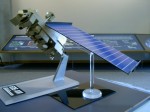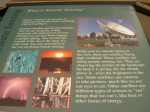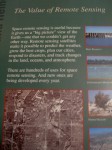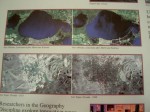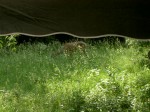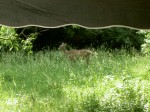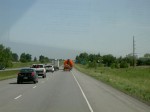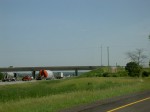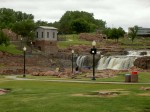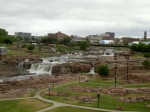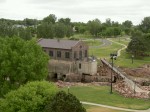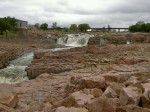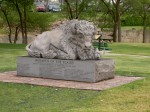Author: sandcastle
EROS
Exotic but not erotic.
EROS currently stands for Earth Resource Observation and Science. It has had other interpretations and names over the years but it has always been part of the USGS which is, in turn, part of the U.S. Department of the Interior.
EROS was founded in the mid 1960s to photograph the earth, focusing primarily on the U.S., and to compile photographs taken by others so the data provided by those photographs could be made usable. EROS has five areas of study: geography, geology, biology, water, and geospatial information. That last one is where they provide information to the public like the photo below.
Here’s a model of a LandSat like those used to take most of the photos.
In it’s photos one pixel equals thirty meters or about one football field. In Google Earth’s photos one pixel equals one meter or about three feet. Eros looks for overall patterns not detail.
This photography is called “remote sensing.”
People and organizations worldwide make use of those photos and the data they provide. You might buy an aerial photo of the family farm or a UGSG topo map of an area you plan to hike Fish and wildlife people study habitats to help determine what should be hunted or put on the endangered species list. Forecasters study land and vegetation changes to predict such things as wildfires, volcano eruptions, and floods and the impacts of those. Their goal is to prevent natural hazards from becoming disasters.
Studying some of the data revealed that converting wetland to crop lands in southern Florida changed the weather there. Water doesn’t lose heat as quickly as land does. Draining the water to make land for growing crops caused temperatures to drop further and faster so the crops froze. This is one of those “unintended consequences” Dave is so fond of discovering.
I learned most of this from the exhibits in the atrium. Dave took the guided tour. He said the computer room was interesting. But unless you are into computers, you might want to just stick to the exhibits. They are open Monday through Friday from 8 a.m. to 4 p.m. The tours are at 10 a.m. and 2 p.m. It’s all free but this is a secure facility so do bring a photo ID and no weapons. Dave even had to leave his tiny pocket knife at the front desk. But they didn’t frisk me when I set off the metal detector. Darn.
TTYL,
Linda
Illinois, Iowa, & South Dakota
OK, so it’s been more than a few days; I’ve made you wait a whole week while I tried to get into the mood to write. Sometimes I just don’t feel like writing. But I’ve kept taking notes so maybe I can catch you up to date on the mostly boring things we’ve been doing. Don’t say I didn’t warn you.
When last we talked we were sitting in Kickapoo State park in Illinois visiting with our dear daughter and watching another deer. To give you an idea how close it was, that’s our awning at the top of the picture. It wandered around grazing peacefully for quite some time.
We enjoyed our afternoon with our daughter discussing what we’ve been up to and what’s ahead for all of us. Her pending move to Maine is not making me happy but it will make her happy which, in turn, makes the mother in me happy. And we are headed for a summer of Minnesota which makes me worried even though I am looking forward to seeing friends and family there. My worry is that we might not leave again and I really cannot face another Minnesota winter. I understand my own mother better now who left Minnesota back when Dave & I followed the Army’s instructions to live in Texas for a couple of years. Mom moved to Colorado then complained that we were back in Minnesota. She couldn’t come back to Minnesota, though, and now I get that.
Fuel. Our RV uses Ultra Low Sulphur Diesel fuel. That’s not available at every gas pump. We’ve learned to look for pumps that have two handles since diesel cannot use the same nozzle gasoline does. We’ve also learned to look for green handles since most diesel pumps are green. But neither of those guarantees diesel is what will come out of that pump. Nor does it guarantee it will not be bio-diesel in a percentage that makes our engine unhappy. So we must read the label on every pump to be sure we are putting the right fuel in our tank. It’s a good thing we are both readers.
We passed through an area apparently big on gun ownership. I saw several signs of the old Burma Shave type apparently sponsored by an organization called GunsSaveLives.com. I’m not sure my take on them was what they intended “When danger lurks, Remember Sonny, That rabbit’s foot, Won’t save no bunny.” Nope, the gun will kill the bunny not save it. “Here’s a thought, For you to ponder: An armed citizen, As first responder.” Shudder! If I’m in trouble I sure don’t want someone coming at me with a gun to be the first thing I see. “Shooting sports Are safe and fun. There’s no need To fear a gun.” So why does the news often contain reports of hunters shooting one another? Anyone up for hunting with Dick Cheney? I’m not a fan of guns. I refused to let our daughter even pretend to have one when she was a child. Of course, she has one now and goes to the shooting range for fun. I simply don’t understand and probably never will. Please, don’t waste your time and mine trying to persuade me otherwise.
Rainy day traveling is a mixed blessing. It increases drowsiness so we need to take breaks more often. But road work has been postponed so the barricades are off on the shoulder and all the lanes are open.
For those of you who will be traveling though Illinois and who care about such things–Illinois rest areas have recycling bins.
We saw a disconnect truck. The front half of the trailer is held to the back half of the trailer only by the load between the two. This is the second one we’ve seen recently. I managed to get some not-very-good pictures of this one.
We saw a Pilot station that sold only diesel fuel–no gasoline. That’s different. $2.449 a gallon.
We stopped for a night at a Coral Lake Corps of Engineer’s campground. They have several of them in this area. We stayed at the West Overlook which has a dump with a fresh water fill. Our site was on a peninsula so we had water views from both sides of the dinette. But we were close enough to our neighbors to hear the father reading a bedtime story to the child–There Was an Old Lady Who Swallowed a Fly. So I had that song stuck in my head the rest of the evening and probably will again for awhile now.
The next day we drove to Forest City, Iowa, to the Winnebago Factory where we did not have an appointment. They still got us in the next day and did all the warranty repairs and one of the upgrades on our list. Hopefully it will never again rain inside our RV and our coach door will always lock when it sounds like it did. Plus, we now have a single lever faucet in our bathroom sink so I can adjust water temperature without leaving big puddles on the counter.
Then we drove to Sioux Falls, South Dakota, where we camped several nights at the Big Sioux Recreation Area, a very nice park with very private sites just east of town.
Sioux Falls is now our legal home so we did normal errands here like picking up our mail and getting groceries and learning about renewing license plates. We also visited Falls Park which is something both locals and tourists do.
We also visited EROS but that probably needs its own blog post.
TTYL,
Linda
Leaks!
Leak #1: the one in our cab area that let’s it rain in when driving through a downpour. Dave called Winnebago and made arrangements for them to fix that one when we get to their factory–probably Friday.
Leak #2: one of our detectors went off last evening. We thought it was smoke although we couldn’t find a source. We opened windows and vents and it dissipated. Then about 1 a.m. the alarm went off again. This time Dave decided it was probably a propane leak. He used our find-the-propane-leak gadget which said the leak was probably somewhere by the stove. But there’s not much you can do about a propane leak in the middle of the night so he turned off the propane, cracked open a window and the ceiling vent, and we went back to bed. This morning Dave is unable to find any evidence of a propane leak so maybe it was something else in this park that won’t be a problem once we leave here. Unless our detector goes off again, we’ll try not to worry about it. If it does go off again, at least we are headed to the factory; they can fix it.
Leak #3: sticky spots on the floor this morning. Are they from the rain that came in through the vent during the night? Rain isn’t usually sticky, though. While fixing breakfast, Dave found the leak In a carton of Coffee Rich thawing on the shelf of the door in the frig. It’s not yet thawed enough to be able to pour it into another container. So the carton is now sitting in a freezer bag back in the door now that Dave has cleaned up all the mess it made.
It’s good to have Dave ready and able to deal with all these leaks.
TTYL,
Linda
Indiana
Another day, another state. Lately we’ve been crossing them at the rate of one a day. Our first stop of the day today was at the Indiana Welcome Center to, of course, pick up another state map. We are getting quite a collection of them.
My first amusing sight of the day was a horizontal tank painted to look like an ear of corn. Yup, I’m nearly home. One of my homes anyway. I’ve had several over the years. I spent fifteen of those years living in Illinois and that is corn and soybean country. So a tank painted to look like an ear of corn feels like home to me.
Next I saw a truck with a sign on the back saying, “Caution. Show chickens inside.” Show chickens? There really are such things? I mean, sure 4H kids raise chickens and take them to the fair to win prizes but an entire semi-truck of show chickens? It made me wonder what type of show. Do you suppose they do tricks like the Wonder Dog does?
We went to a Waffle House for lunch. When Dave starts talking about waffles I know we are headed someplace where he can get one soon. So, I started thinking what I would order when we went there. I decided I’d have one of my favorite breakfasts that I rarely indulge in: two eggs over easy mixed with hash-browns and bacon with a side of whole wheat toast with jelly. So, imagine my surprise when I heard myself order eggs scrambled with cheese, hash-browns, bacon and toasted raisin bread. At least I got the hash-browns and bacon right. Although, Dave ate half my bacon because that turned out to be too much food for me. It was tasty, though.
When we crossed the Big Blue River I noticed it was green. The color green, not the ecological green. I think green rivers probably aren’t too ecologically sound.
The billboard for Cracker Barrel said, “Table for two. Coming right up.” But the picture that went with it was of a checkerboard. You know, the ones they have on their porch so you can play checkers while you wait for your table which is, obviously, not “Coming right up.”
I saw a water tower with the words, “Indiana. American Water,” on it. I wonder if that was painted in response to the huge popularity of Perrier a few years ago. Then I wondered why a city would care if it’s citizens didn’t drink the local water. Wouldn’t that mean they’d have to process less of it? Then I remembered that back when we had a house our sewer bill was a percent of our water bill. If the citizens aren’t drinking the local water the percentage cost of sewage processing would go up and people would complain about that. So drink locally, folks.
A beer billboard said, “Best taste deserves protection.” Many beer drinkers nowadays associate protection with condoms. So, your beer deserves a condom?
Another beer billboard showed a picture of a six pack with the label “Stimulus Package.” Be careful how much beer you drink; it can affect what you stimulate. Which would never have occurred to me if we hadn’t just been told your beer deserves a condom.
We ran into a flight of bugs which splattered all over our windshield. Without even knowing what I was thinking about the beer ads, Dave asked me if they were Love Bugs. Even if I knew what a Love Bug looked like I wouldn’t have been able to tell if those on our windshield were them from the little evidence they left.
Fortunately, we drove through a down pour shortly after that which washed the bugs off the windshield. Yay!
In the few minutes we drove through that rain the temperature dropped 22 degrees. It’s now a clean, cool world out there.
Unfortunately, we didn’t stay there. We drove on into hot and humid. Then on some more into Illinois to Kickapoo State Park where we will spend the next two nights.
Yes, we are hurrying towards home. But we are just 20 miles from Urbana, Illinois, where our daughter will be tomorrow. And she is one of our homes wherever she is. Since she’s in the process of gathering her things to move to Maine, we won’t get to visit that home as often as we would like to do in the future. So we are NOT going to pass up this chance to spend a day with her now. Everything else can wait another day.
TTYL,
Linda



